What does past climate change tell us about global warming?
What the science says...
| Select a level... |
 Basic
Basic
|
 Intermediate
Intermediate
| |||
|
Greenhouse gasses, principally CO2, have controlled most ancient climate changes. This time around humans are the cause, mainly by our CO2 emissions. |
|||||
Climate Myth...
Climate's changed before
Climate is always changing. We have had ice ages and warmer periods when alligators were found in Spitzbergen. Ice ages have occurred in a hundred thousand year cycle for the last 700 thousand years, and there have been previous periods that appear to have been warmer than the present despite CO2 levels being lower than they are now. More recently, we have had the medieval warm period and the little ice age. (Richard Lindzen)
At a glance
Just imagine for a moment. You fancy having a picnic tomorrow, or you're a farmer needing a dry day to harvest a ripe crop. So naturally, you tune in for a weather-forecast. But what you get is:
“Here is the weather forecast. There will be weather today and tomorrow. Good morning.”
That's a fat lot of use, isn't it? The same applies to, “the climate's changed before”. It's a useless statement. Why? Because it omits details. It doesn't tell you what happened.
Climate has indeed changed in the past with various impacts depending on the speed and type of that change. Such results have included everything from slow changes to ecosystems over millions of years - through to sudden mass-extinctions. Rapid climate change, of the type we're causing through our enormous carbon dioxide emissions, falls into the very dangerous camp. That's because the faster the change, the harder it is for nature to cope. We are part of nature so if it goes down, it takes us with it.
So anyone who dismissively tells you, “the climate has always changed”, either does not know what they are talking about or they are deliberately trying to mislead you.
Please use this form to provide feedback about this new "At a glance" section. Read a more technical version below or dig deeper via the tabs above!
Further Details
Past changes in climate, for which hard evidence is preserved throughout the geological record, have had a number of drivers usually acting in combination. Plate tectonics and volcanism, perturbations in Earth's slow carbon cycle and cyclic changes in Earth's orbit have all played their part. The orbital changes, described by the Milankovitch Cycles, are sufficient to initiate the flips from glacials (when ice-sheets spread over much of Northern Europe and the North American continent) to interglacials (conditions like the past few thousand years) and back – but only with assistance from other climate feedbacks.
The key driver that forces the climate from Hothouse to Icehouse and back is instead the slow carbon cycle. The slow carbon cycle can be regarded as Earth's thermostat. It involves the movement of carbon between vast geological reservoirs and Earth's atmosphere. Reservoirs include the fossil fuels (coal/oil/gas) and limestone (made up of calcium carbonate). They can store the carbon safely over tens of millions of years or more. But such storage systems can be disturbed.
Carbon can be released from such geological reservoirs by a variety of processes. If rocks are uplifted to form mountain ranges, erosion occurs and the rocks are broken down. Metamorphism – changes inflicted on rocks due to high temperatures and pressures – causes some minerals to chemically break down. New minerals are formed but the carbon may be released. Plate tectonic movements are also associated with volcanism that releases carbon from deep inside Earth's mantle. Today it is estimated by the U.S. Geological Survey that the world's volcanoes release between 180 and 440 million tonnes of carbon dioxide per year - as opposed to the ~35 billion tonnes we release.
Epic carbon releases in the geological past
An extreme carbon-releasing mechanism can occur when magma invades a sedimentary basin containing extensive deposits of fossil fuels. Fortunately, this is an infrequent phenomenon. But it has nevertheless happened at times, including an episode 250 million years ago at the end of the Permian Period. In what is now known as Siberia, a vast volcanic plumbing-system became established, within a large sedimentary basin. Strata spanning hundreds of millions of years filled that basin, including many large coal, oil, gas and salt deposits. The copious rising magma encountered these deposits and quite literally cooked them (fig. 1).
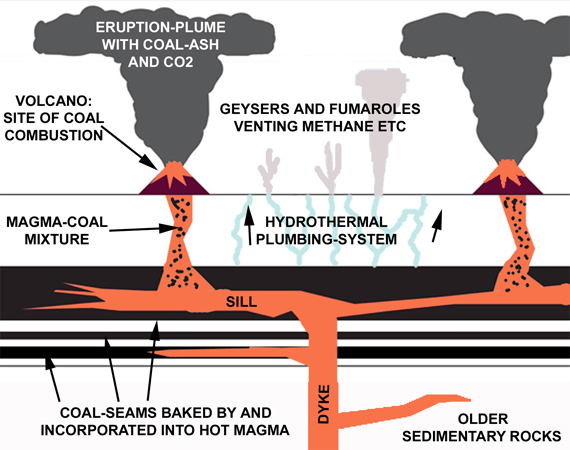
Fig. 1: schematic cross section though just a part of the Siberian Traps Large Igneous Province, showing what science has determined was going on back then, at the end of the Permian Period.
Now laden with a heavy payload of gases, boiled out of the fossil fuel deposits, some of the magma carried on up to the surface to be erupted on a massive scale. The eruptions – volcanism on a scale Mankind has never witnessed - produced lavas that cover an area hundreds of kilometres across. Known as the Siberian Traps, because of the distinctive stepped landforms produced by the multiple flows, it has been calculated that the eruptions produced at least three million cubic kilometres of volcanic products. Just for a moment think of Mount St Helens and its cataclysmic May 1980 eruption, captured on film. How many cubic kilometres with that one? Less than ten.
Recently, geologists working in this part of Siberia have found and documented numerous masses of part-combusted coal entrapped in the lavas (Elkins-Tanton et al. 2020; fig. 2). In the same district are abundant mineral deposits formed in large pipes of shattered rock as the boiling waters and gases were driven upwards by the heat from the magma.
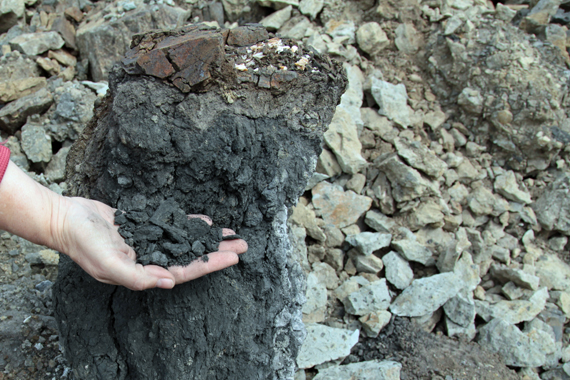
Fig. 2: an end-Permian smoking gun? One of countless masses of part-combusted coal enclosed by basalt of the Siberian Traps. Photo: Scott Simper, courtesy of Lindy Elkins-Tanton.
It has been calculated that as a consequence of the Siberian Traps eruptions, between ten trillion and one hundred trillion tons of carbon dioxide were released to the atmosphere over just a few tens of thousands of years. The estimated CO2 emission-rate ranges between 500 and 5000 billion tonnes per century. Pollution from the Siberian Traps eruptions caused rapid global warming and the greatest mass-extinction in the fossil record (Burgess et al, 2017). There are multiple lines of hard geological evidence to support that statement.
We simply break into those ancient carbon reservoirs via opencast or underground mines and oil/gas wells. Through such infrastructure, the ancient carbon is extracted and burned. At what rate? Our current carbon dioxide emissions are not dissimilar to the estimated range for the Siberian Traps eruptions, at more than 3,000 billion tons per century. The warning could not be more clear. Those telling you the climate's changed before are omitting the critical bit – the details. And when you look at the details, it's not always a pretty sight.
Last updated on 14 February 2023 by John Mason. View Archives































 Arguments
Arguments









































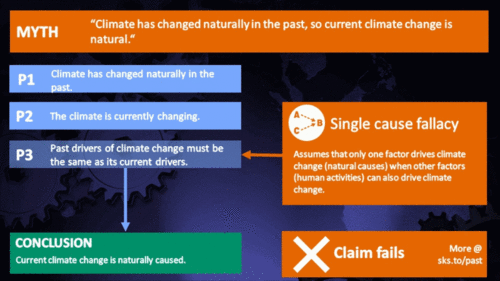







TVC15.
Your interlocutor seems to be using a combination of "Climate has changed before" (this thread) and "we're coming out of an ice age", which is an odd twist on "we're going into an ice age". Maybe he's confused with "we're coming out of the Little Ice Age".
There is a post here at SkS that talks about sea level over the past 150,000 years. It includes the following graph of sea level, covering the last glaclal/interglacial cycle:
I do not see anything on that graph to support his claim that sea level is normally 4 to 14m higher than now during interglacials. The peaks of that graph may be a touch higher, but there sure isn't a steady period of higher sea levels in the last interglacial. I suspect his claim is completely bogus, but you could always try to get him to provide his source of data.
On very long time periods, ocean basin size/shape changes have dramatic effects on relative sea level. On short time scales (glacial/interglacial cycles), local sea level in areas subject to the weight of ice have serous effects due to isostatic depression and rebound.
Of course, the answer to "why should this interglacial be different?" is "because we're adding CO2 to higher levels than seen in hundreds of thousands of years, and we're looking at rising temperatures and conditions not seen in past interglacials".
Eclectic @874, 875
Hi Electric,
Thanks for the responses!
I don’t understand why this denier is trying to make it a fact that the Western half of the US always undergoes a drought during Inter-Glacial Periods when I don’t think we really know, or do we?
They mention the other 11 interglacial periods, during which modern humans did not exist until the Holocene. I’ve also head a new epoch called the Anthropocene, with the start date of this new epoch still in debate. Not sure if this is recognized as the most current epoch.
Since humans did not occupy most of those interglacial cycles, I don’t understand the deniers argument. There is nothing to connect the dots between past interglacials and our current situation.
Now instead of saying climate always changes, deniers are claiming that what we are witnessing all over the globe today is typical during an interglacial cycle.
How can we know the conditions of ancient interglacials? Did they all cause drought in the Western half of the US?
Thanks!
Bob Loblaw@876
[Sea levels are normally 4 meters to 14 meters higher than they are now during Inter-Glacial Periods.]
Thanks so much for responding to this deiners claim and providing that graph!
TVC15 , from experience, you know how anything & everything is grist for the deniers' mill, in their attempts to minimize and/or deny the climate science. It's always ABCD ~ Anything But Carbon Dioxide.
And their excuses come in cycles of excuse ~ first: It's Not Warming . . . then: It's only warming a bit . . . then: Yes, it's warming a lot, but it's Not caused by humans . . . then: Well yes it's half-caused by humans, but the Warming is really very very good for us and is saving us from disastrous cooling.
Then it's back to: the Warming has Stopped and it's cooling now (for at least 6 years' cooling, says the deluded Monckton) . . . and a Colossal Grand Solar Minimum will have all of Canada under a mile-thick ice sheet by 2050 or somesuch date.
For millennia, the US Southwest has been arid - the opposite of the Northeast. And you can find other regions of the world likewise arid. All it needs is a slight variation in climate, and you've got a mega-drought (a drought defined as >20 years) or a super-mega-drought (for centuries). Nothing very new about that ~ except that now our Anthropogenic global warming is exacerbating the droughty tendency. (The exacerbation being the point your denier wishes to deny.)
I haven't studied past Interglacials w.r.t. aridity & droughts. Presumably similar overall conditions in the past have caused rather similar episodes. But that's all rather irrelevant to the current situation, which must be dealt with on its own terms. And the current droughty tendency doesn't disprove the climate science, nor does it fail to point to more of the same trouble in future, as AGW worsens.
Of course, as we look back in time, the proxy evidence (in past Interglacials) gets fuzzier & fuzzier ~ so conclusions of any sort get more difficult to make.
The "Anthropocene" is a semi-humorous label. Not official. But the label does get up the deniers' noses. Still, it does rhetorically emphasize that the Holocene is transitioning into something significantly different from the "natural".
A follow-up to the "sea level was higher in past interglacials" claim.
Is this person claiming that sea level is indeed rising to dangerous levels, but it's natural?
Is this person claiming that sea level has risen naturally in the past, so rising CO2 and rising temperatures cannot change this previous pattern?
The part TVC15 has quoted is the usualy mishmash of vague, unspecific claims. Good luck trying to pin the denier down to a specific claim or statement that can be examined by evidence - my experience is that such individuals often are incapable of expressing themselves clearly enough.
TVC15 @873,
Your denialist is actually making four bold statements that are patently nonsense with the rather pathetic request that you "Tell us why this Inter-Glacial Period should be different."
"Ice sheets and glaciers always melt during Inter-Glacial Periods." The melting actually happens in the run-up to the "Inter-Glacial Periods" which is what makes them "Inter-Glacial Periods" so in one respect this is entirely straw man territory. If the bold assertion is that glaciers and ice sheets shrink as they do today throughout an inter-glacial, that is false as sea levels of past millennia demonstrate.
"Sea levels are normally 4 meters to 14 meters higher than they are now during Inter-Glacial Periods." This is not supported by the evidence that
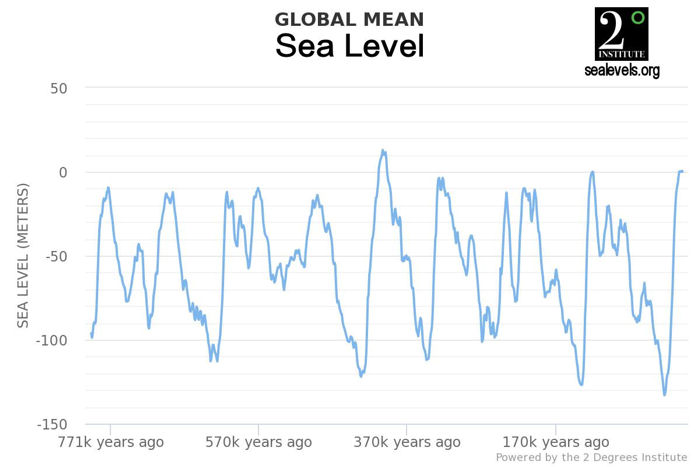
suggests only two or three of the eight had higher sea levels. (The graphic is from here but originates from this web engine.)
"Global temperatures in the other 8 previous Inter-Glacial Periods were at least 7°F warmer than present." Again not supported by the evidence. A google search provides many graphical representations of 800,000y temperatures and globally the present interglacial has been warmer than all but three of them (although AGW may be on course to change that ranking).
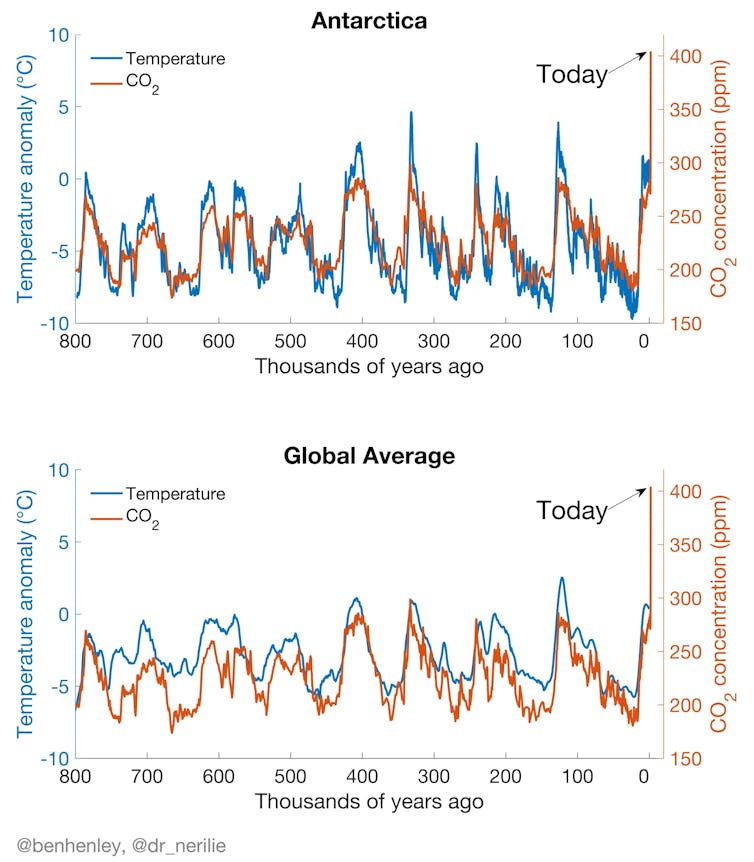
"The West always undergoes a drought during Inter-Glacial Periods." This is a more specialist assertion. That there has been "a drought" in "the West" through the Holocene is potentially correct. It isn't a place with massive rainfall. But more accurately there are periods of drought and periods when the rain is heavier. What we see to make sense of that is a bit of a Hockey Stick situation with drought conditions becoming more wide-spread. The graphic comes from here an account which does address the question "Will anthropogenic climate change cause the West to get drier or wetter?"
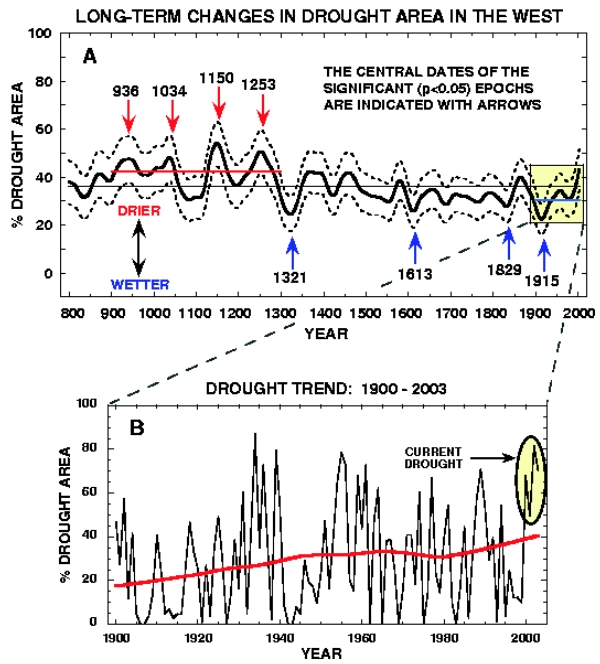
IIRC, the Last Glacial Maximum saw a greater buildup of land-based ice than in previous glacial phases. By the time maximum warming in the Holocene had been achieved and a natural cooling initiated, a great deal of ice remained in Greenland and Antarctica that had already been lost by that same point in previous interglacials.
Given time to reach equilibrium with the modern forcing, global sea levels will eventually surpass any levels achieved in previous interglacials spanning the previous 800,000 years+, and likely far longer than that.
From Dutton 2015, Figure 5:
Many thanks to Eclectic, Bob Loblaw, MA Rodger and Daniel Bailey.
I gain so much from each of you every time I post denier claims.
Thank you all for your time and efforts to help educate us!
How valid is the claim, in refuting man-made climate change, that the Earth's climate has changed before?
Your honor, I can’t be convicted of murder.
You see, people have been dying since before I was born.
So death is a natural thing, not caused by me. And probably nothing to worry about.
Plus, you can’t prove that I killed that guy.
Sure, I stabbed him, but all you can prove is that this caused localized cell death at the micro scale, not that it caused him to die.
People survive stabbings all the time, in fact, stabbing a scalpel in people is often healthy, doctors do it all the time!
I only stabbed 0.4% of his body, so it can’t be an issue, my stab is barely 3% of his body cavities.
And the models are so unreliable.
Doctors can’t even predict with 100% accuracy if someone will survive a surgery or not, how can they claim to suddenly know that this particular stab was bad?
Science has been wrong before!
So you see, I can’t be convicted of murder.
Now stop trying to push this radical anti-stabbing agenda.
Source
When we say that CO2 and Temperature are correlated, which one comes first in that interaction ? I mean, is it the temperature that influences de CO2 or the CO2 that influences temperature ? Which one is the most significant, which one drives the most between the two ? Also, where can we find a comprehensive study, comparing the natural causes for climate changes over the last few millions years (or more if possible) compared to recent data, which would include the human factor, let's say since 1850 ?
paulbegin @885,
Increased concentrations of CO2 in the atmosphere will increase global temperatures directly through the greenhouse effect. An increase in temperature can influence CO2 concentrations but less directly. Thus colder oceans are more able to absorb CO2 so CO2 will be drawn from the atmosphere into the oceans during an ice age, this increasing the ice age cooling. But there are other temperature-CO2 correlations, for instance during the ENSO cycle with temperature and CO2 increasing in the aftermath of an El Niño. Yet in the ENSO cycle the fluctuating CO2 levels are not due to temperature but due to changing patterns of rainfall causing changes in vegitation growth in the Amazon basin.
So it is CO2 that drives temperture while temperature has a small influence on CO2.
I'm not emtirely sure what you are asking for with your last question. The various drivers of climate change, be they forcings or the resulting feedbacks, are reasonably well understood for the past few million years but there is more difficulty going back into the more distant past as the drivers and the climate are less well understood.
The big difference between the last few-million-years and the last century-or-so is that the major climate forcing has resulted from human activity and that said, I'm not sure what you expect from comparing the last century-or-so with the last few-million-years.
I agree with the statement. CO2 and global warming are definitely correlated, the more CO2 we have will indeed warmup the Earth. And your rebuttal to the myth is excellent in my opinion, what happened in the past surely doesn't mean that what's happening now is the same. Us humans are changing the climate. Lastly, I do have a question regarding the CO2 level, until how much would think that the climate can handle?
There were changes in climate that caused species extinctions, but those changes were caused by physical impact in scale and duration far beyond what we can do by adding CO2 to the atmosphere.
Welcome to Skeptical Science, hmmyes and Fya.
hmmyes: you ask about how much CO2 the climate can handle? The earth-atmosphere system can handle a lot, and climate will always be there - it is simply what is observed, however cold or hot things are. From a human perspective, though, there are an awful lot of climates that earth can tolerate that humans cannot. 18,000 years ago was 4-6 C cooler than now, and cie covered huge areas of current land. Running today's modern civilation in that earth would be very difficult. On the flip side, a 4-6C warming would also be very expensive for humans, if not intolerable. The past changes in climate tell us that 4-6C of change is a big change.
Fya: mass extinctions from things like meteor impacts are indeed a very abrupt and severe form of change, and CO2 wll not have that rapid effect. But the effects of a 4-6C rise in temperatures (the high end of esitmates for a doubling of CO2 from 300 to 600ppm) will not be gentle.
Global warming has always been one of the most concerning and dangerous things that humans and the climate can experience. Global warming is when the concentration of greenhouse gases like carbon dioxide increases in the atmosphere, making the planet heat up.
Although global warming is genuinely concerning, a lot of people all over the world still look over it and do not seem to really care. This might be because people think that global warming is impossible to solve since we still need to use the stuff that is causing the problem, like burning fossil fuels. But for me, I do not think that is the case.
I think that global warming is especially important because it affects us as human beings e.g., extremely hot weather can damage our lungs. Moreover, it affects a variety of biodiversity across the world. An example would be in the polar regions where it starts to get warm which leads to animal deaths. I believe that we can help solve this problem and make the planet a good place to live in again. We just need to put our hands together and fight through it. We can start off by raising awareness and using fewer fossil fuels.
Please note: the basic version of this rebuttal has been updated on Feb 14, 2023 and now includes an "at a glance“ section at the top. To learn more about these updates and how you can help with evaluating their effectiveness, please check out the accompanying blog post @
https://sks.to/at-a-glance
Thanks - the Skeptical Science Team.
i think ther is mistake in italian version:
"I cambiamenti naturali del Clima del passato dimostrano che il Clima risente delle alterazioni del bilancio energetico. Se il pianeta accumula calore le temperature globali salgono. "
The planet don't accumulate heat (because is only transfer), the planet accumulate energy , not heat , the heat is only conseguence of more energy in the system
iv @892 ,
Please forgive my intrusion ( I speak no Italian ) but in English conversation about climate and climate science, many people use heat and energy as identical terms. Sometimes that is justified, and sometimes not justified.
Perhaps the original translation intends to convey one meaning - or both meanings. What is your own preference in translating ?
http://cedric.ringenbach.com/2009/11/22/vous-etes-ici/
It is in french but it is worth reading.
[PS] Nope it isnt. Long ago debunked and not relevant to this topic. Link only posts are permitted by comments policy. The correct way to engage is first choose the appropriate place, make your argument and use links to published literature to support your argument.
Cork:
Your link is an article from 2012. I see nothing that relates to your previous posts. The conclusions of the link are the same asw what we discuss here at SkS. What is your point?
The moderators often delete link only posts. You have to say why the link is interesting, not just say it is interesting. It was a waste of my time.
i have question/comment about the Intermediate Conclusion to Myth #1,
"To summarize, none of the mechanisms which facilitated previous climate change can explain the rapid rise in both CO2 and temperature observed over the past 150 years. However, human-released CO2 explains both!"
Wouldn't it be clearer and more definitive to say, "... can explain neither the rapid rise in CO2 or temperature over the past 150 years."?
The rise in temperature is 10 - 20 times faster than anyting observed before, e.g. warming after the last glacial age. LINK
The rise in CO2 is 10x faster than during the PETM and 100x faster than the last glacial age.
LINK
LINK
[RH] Links shortened and activated
Recommended Supplemental Reading:
Yes, there was global warming in prehistoric times. But nothing in millions of years compares with what we see today, Opinion by Michael E Mann, Los Angeles Times, Sep 24, 2023
As this is your first post, Skeptical Science respectfully reminds you to please follow our comments policy. Thank You!
I am surprised that the rapid temperature increase which happened about 15'000 years ago during Bolling-Allerod period is not mentionned. Records indicate a 3C warming in less than 90 years, and therefore was way faster than current warming. Those records are specific to the gulf of Alaska and do not prove by themselves that the warming was global. However brutal variations of Delta18 ratio have also been observed in Greenland and India at the same peiod (I have not checked if it was at the exact same time). I would be interested by comments of experts about this. Thank you.
Spooky @899 , you should not really be surprised ~ since the OP article is referring to Global temperature changes.
Not to the local rapid changes in the boreal icesheet region (e.g. Denmark, Greenland, Alaska : during the last glacial age) as shown in the Bolling-Allerod warming and in the briefer Dansgaard-Oeschger events. Those local northern regions are affected by "sudden" changes in local oceanic currents ~ both smaller & larger (e.g. the AMOC). But that has little effect on the global scale, except when it involves a massive event like the melting of the Laurentide Ice Sheet (i.e. the Younger Dryas).
In India, the Indian Monsoons (to which you allude) show much fluctuation resulting from very small alterations in local temperatures & winds (winds which may bring more oxygen18-rich water) . . . even in the absence of a 30-year climate change.
For global temperature changes, there need to be global-scale changes in albedo / insolation / particulates / or greenhouse gasses.